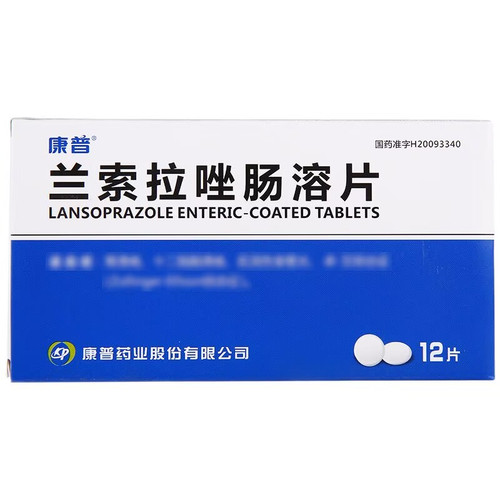Product Overview
[Drug Name]
Generic Name: Lansoprazole Enteric-Coated Tablets
Trade Name: Licolan Lansoprazole Enteric-Coated Tablets 15mg x 18 Tablets
Pinyin Code: Lan Suo La Zuo Chang Rong Pian
[Main Ingredients]
The main ingredient of this product is lansoprazole.
[Properties]
This product is an enteric-coated tablet that appears white or light yellow-brown after removing the coating.
[Indications/Main Functions]
Gastric ulcer, duodenal ulcer, reflux esophagitis, Zollinger-Elison syndrome (gastrinoma).
[Specifications]
15mg x 18 tablets (Licolan)
[Dosage and Administration]
Oral. For the treatment of gastric and duodenal ulcers, take 15-30mg orally once daily in the morning. For duodenal ulcers, continue for 4-6 weeks.
[Adverse Reactions]
1. Allergic Reactions: Occasionally, symptoms such as rash and itching may occur. Discontinue use if these symptoms occur.
2. Hematologic System: Occasionally, symptoms such as anemia, leukopenia, and eosinophilia may occur. Thrombocytopenia rarely occurs.
3. Digestive System: Occasionally, symptoms such as constipation, diarrhea, thirst, and abdominal distension may occur. Elevated levels of GOT, GPT, ALP, LDH, and γ-GTP may occur. Careful observation is required. If any abnormalities are detected, appropriate measures should be taken, including discontinuation of the drug.
4. Neuropsychiatric System: Occasionally, symptoms such as headache and drowsiness may occur. Insomnia and dizziness are rare.
5. Genitourinary System: Frequent urination, proteinuria, and impotence may occur.
6. Other: Occasionally, symptoms such as fever, elevated total cholesterol, and elevated uric acid may occur.
[Contraindications]
This product is contraindicated in patients with allergies.
[Drug Interactions]
Lansoprazole may delay the metabolism and excretion of diazepam and phenytoin, increasing the peak plasma concentration of acetaminophen and shortening its duration.
[Precautions]
1. Observation is recommended during treatment. Due to insufficient experience with long-term use, maintenance therapy is not currently recommended.
2. Do not chew this tablet; swallow it whole with water.
3. Use with caution in patients with liver dysfunction and the elderly.
4. This product may mask the symptoms of gastric cancer; therefore, it should only be used after gastric cancer has been ruled out.
[Use in Children]
Unclear.
[Use in Elderly Patients]
Generally, elderly patients experience decreased gastric acid secretion and other physiological functions. Observation is recommended during medication use.
[Overdose]
Unclear.
[Pharmacology and Toxicology]
1. This product is a benzimidazole compound. After oral absorption, it is translocated to the gastric mucosa and converted into an active metabolite under acidic conditions. This active metabolite specifically inhibits the H+/K+-ATPase system in gastric parietal cells, thereby blocking the final step of gastric acid secretion. This product inhibits basal and stimulated gastric acid secretion in a dose-dependent manner. It has no antagonistic effect on cholinergic and histamine H2 receptors.
2. Genotoxicity: The Ames test, rat hepatocyte unscheduled DNA synthesis test, mouse micronucleus test, and rat bone marrow cell chromosomal aberration test were all negative. The in vitro human lymphocyte chromosomal aberration test was positive.
3. Reproductive Toxicity: Oral administration of this product at 150 mg/kg/day (equivalent to 40 times the human dose based on body surface area) did not affect reproductive capacity or reproductive behavior in rats. Teratogenicity studies showed that oral administration of 150 mg/kg/day of this drug to pregnant rats and 30 mg/kg/day of this drug to pregnant rats (equivalent to 16 times the human dose based on body surface area conversion) did not cause teratogenic effects on the fetuses. This drug and its metabolites can be secreted into rat milk.
4. Carcinogenicity studies: SD rats were given oral doses of 5 to 150 mg/kg/day of this drug for 24 consecutive months. Results showed that this drug induced gastrointestinal chromaffin-like (ECL) cell proliferation and benign ECL cell tumors in a dose-dependent manner. The frequency of intestinal metaplasia in the stomach of the test animals increased. The incidence of testicular Leydig cell adenomas in male rats increased in a dose-dependent manner. CD-1 mice were orally administered 15-600 mg/kg/day of this drug (equivalent to 2-80 times the human dose based on body surface area) for 24 consecutive months. This drug induced ECL cell proliferation in a dose-dependent manner, and the incidence of liver tumors in the mice increased. The incidence of tumors in male mice in the 300 and 600 mg/kg/day groups and in female mice in the 150 and 600 mg/kg/day groups exceeded the historical incidence range of tumors in this strain of mice. Mice administered 75-600 mg/kg/day of this drug developed rete testis adenomas.








